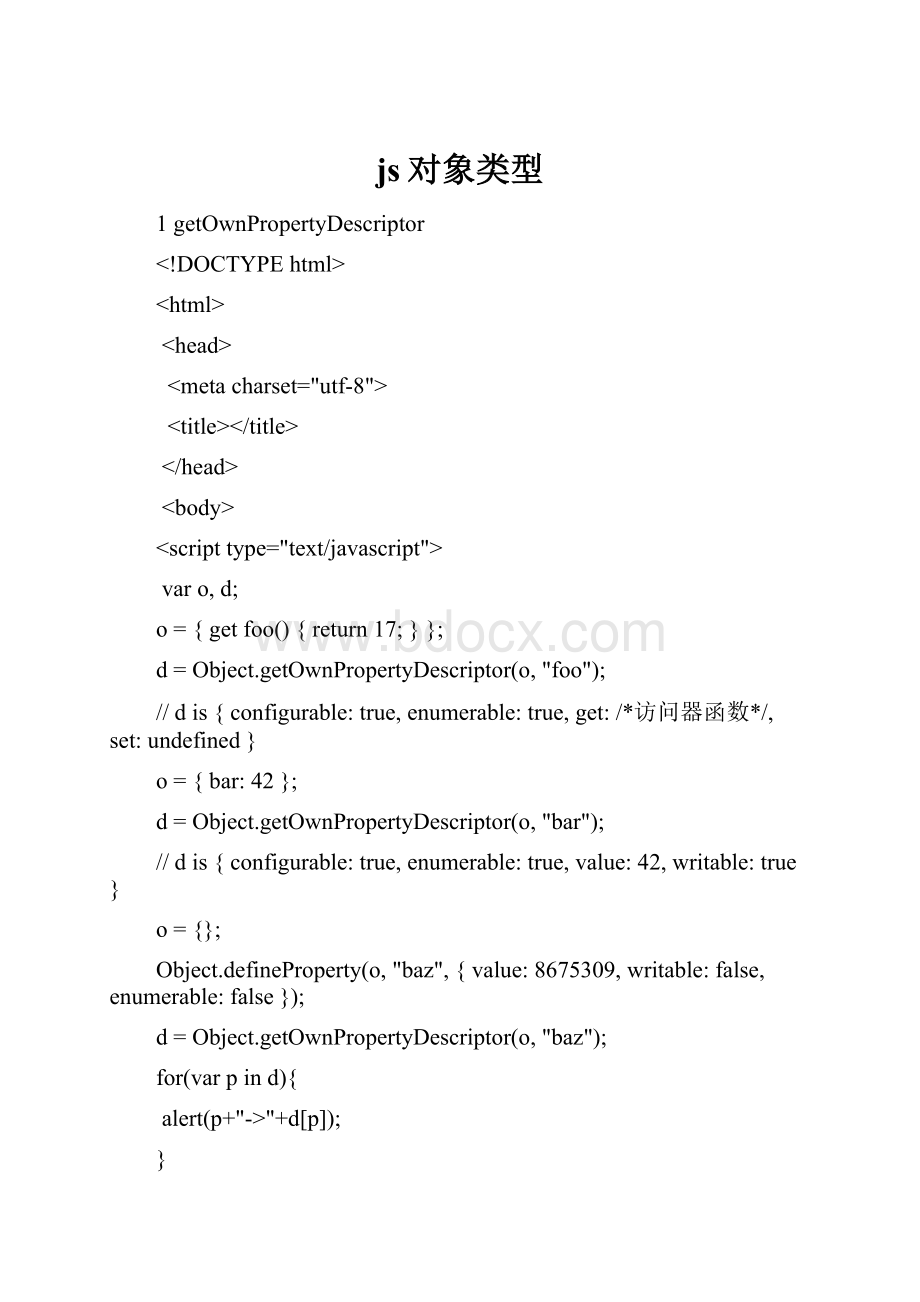js对象类型.docx
《js对象类型.docx》由会员分享,可在线阅读,更多相关《js对象类型.docx(29页珍藏版)》请在冰豆网上搜索。

js对象类型
1getOwnPropertyDescriptor
DOCTYPEhtml>
varo,d;
o={getfoo(){return17;}};
d=Object.getOwnPropertyDescriptor(o,"foo");
//dis{configurable:
true,enumerable:
true,get:
/*访问器函数*/,set:
undefined}
o={bar:
42};
d=Object.getOwnPropertyDescriptor(o,"bar");
//dis{configurable:
true,enumerable:
true,value:
42,writable:
true}
o={};
Object.defineProperty(o,"baz",{value:
8675309,writable:
false,enumerable:
false});
d=Object.getOwnPropertyDescriptor(o,"baz");
for(varpind){
alert(p+"->"+d[p]);
}
//dis{value:
8675309,writable:
false,enumerable:
false,configurable:
false}
2getOwnpropertyNames
DOCTYPEhtml>
//vararr=["a","b","c"];
//alert(Object.getOwnPropertyNames(arr).sort());//输出"0,1,2,length"
//
////类数组对象
//varobj={0:
"a",1:
"b",2:
"c"};
//alert(Object.getOwnPropertyNames(obj).sort());//输出"0,1,2"
//
////使用Array.forEach输出属性名和属性值
//Object.getOwnPropertyNames(obj).forEach(function(val,idx,array){
//alert(val+"->"+obj[val]);
//});
////输出
////0->a
////1->b
////2->c
//
////不可枚举属性
//varmy_obj=Object.create({},{getFoo:
{value:
function(){returnthis.foo;},enumerable:
false}});
//my_obj.foo=1;
//
//alert(Object.getOwnPropertyNames(my_obj).sort());//输出"foo,getFoo"
//下面的例子演示了该方法不会获取到原型链上的属性:
functionParentClass(){}
ParentClass.prototype.inheritedMethod=function(){};
functionChildClass(){
this.prop=5;
this.method=function(){};
}
ChildClass.prototype=newParentClass;
ChildClass.prototype.prototypeMethod=function(){};
alert(Object.getOwnPropertyNames(newChildClass()));//弹出["prop","method"]))
3getPrototypeOf
DOCTYPEhtml>
varproto={};
varobj=Object.create(proto);
alert(Object.getPrototypeOf(obj)===proto);
alert(Object.getPrototypeOf(obj));
4hasOwnProperty
DOCTYPEhtml>
//使用hasOwnProperty方法判断某对象是否含有特定的自身属性
varo=newObject();
o.prop='exits';
functionchangeO(){
o.newprop=o.prop;
deleteo.prop;
}
//alert(o.hasOwnProperty('prop'));
//changeO();
//alert(o.hasOwnProperty('prop'));
//自身属性和继承属性的区别
//o=newObject();
//o.prop='exists';
//alert(o.hasOwnProperty('prop'));//返回true
//alert(o.hasOwnProperty('toString'));//返回false
//alert(o.hasOwnProperty('hasOwnProperty'));//返回false
//遍历一个对象的所有自身属性
//何在遍历一个对象的所有属性时忽略掉继承属性,注意这里for..in循环只会遍历可枚举属性,这通常就是我们想要的,
//直接使用Object.getOwnPropertyNames()方法也可以实现类似的需求。
varbuz={
fog:
'stack'
};
for(varnameinbuz){
if(buz.hasOwnProperty(name)){
alert("thisisfog("+name+")forsure.Value:
"+buz[name]);
}
else{
alert(name);//toStringorsomethingelse
}
}
//hasOwnProperty方法有可能被遮蔽
//如果一个对象拥有自己的hasOwnProperty方法,则原型链上的同名方法会被遮蔽(shadowed)
varfoo={
hasOwnProperty:
function(){
returnfalse;
},
bar:
'Herebedragons'
};
foo.hasOwnProperty('bar');//始终返回false
//如果担心这种情况,可以直接使用原型链上真正的hasOwnProperty方法
alert(({}).hasOwnProperty.call(foo,'bar'));//true
alert(Object.prototype.hasOwnProperty.call(foo,'bar'));//true
5isExtenstion
DOCTYPEhtml>
//新对象默认是可扩展的.
varempty={};
alert(Object.isExtensible(empty)===true);
//...可以变的不可扩展.
Object.preventExtensions(empty);
alert(Object.isExtensible(empty)===false);
//密封对象是不可扩展的.
varsealed=Object.seal({});
alert(Object.isExtensible(sealed)===false);
//冻结对象也是不可扩展.
varfrozen=Object.freeze({});
alert(Object.isExtensible(frozen)===false);
6isFrozen
DOCTYPEhtml>
//一个对象默认是可扩展的,所以它也是非冻结的.
alert(Object.isFrozen({})===false);
//一个不可扩展的空对象同时也是一个冻结对象.
varvacuouslyFrozen=Object.preventExtensions({});
alert(Object.isFrozen(vacuouslyFrozen)===true);
//一个非空对象默认也是非冻结的.
varoneProp={p:
42};
alert(Object.isFrozen(oneProp)===false);
//让这个对象变的不可扩展,并不意味着这个对象变成了冻结对象,
//因为p属性仍然是可以配置的(而且可写的).
Object.preventExtensions(oneProp);
alert(Object.isFrozen(oneProp)===false);
//...如果删除了这个属性,则它会成为一个冻结对象.
deleteoneProp.p;
alert(Object.isFrozen(oneProp)===true);
//一个不可扩展的对象,拥有一个不可写但可配置的属性,则它仍然是非冻结的.
varnonWritable={e:
"plep"};
Object.preventExtensions(nonWritable);
Object.defineProperty(nonWritable,"e",{writable:
false});//变得不可写
alert(Object.isFrozen(nonWritable)===false);
//把这个属性改为不可配置,会让这个对象成为冻结对象.
Object.defineProperty(nonWritable,"e",{configurable:
false});//变得不可配置
alert(Object.isFrozen(nonWritable)===true);
//一个不可扩展的对象,拥有一个不可配置但可写的属性,则它仍然是非冻结的.
varnonConfigurable={release:
"thekraken!
"};
Object.preventExtensions(nonConfigurable);
Object.defineProperty(nonConfigurable,"release",{configurable:
false});
alert(Object.isFrozen(nonConfigurable)===false);
//把这个属性改为不可写,会让这个对象成为冻结对象.
Object.defineProperty(nonConfigurable,"release",{writable:
false});
alert(Object.isFrozen(nonConfigurable)===true);
//一个不可扩展的对象,值拥有一个访问器属性,则它仍然是非冻结的.
varaccessor={getfood(){return"yum";}};
Object.preventExtensions(accessor);
alert(Object.isFrozen(accessor)===false);
//...但把这个属性改为不可配置,会让这个对象成为冻结对象.
Object.defineProperty(accessor,"food",{configurable:
false});
alert(Object.isFrozen(accessor)===true);
//使用Object.freeze是冻结一个对象最方便的方法.
varfrozen={1:
81};
alert(Object.isFrozen(frozen)===false);
Object.freeze(frozen);
alert(Object.isFrozen(frozen)===true);
//一个冻结对象也是一个密封对象.
alert(Object.isSealed(frozen)===true);
//当然,更是一个不可扩展的对象.
alert(Object.isExtensible(frozen)===false);
7isProtype
DOCTYPEhtml>
functionFee(){
//...
}
functionFi(){
//...
}
Fi.prototype=newFee();
functionFo(){
//...
}
Fo.prototype=newFi();
functionFum(){
//...
}
Fum.prototype=newFo();
varfum=newFum();
if(Fi.prototype.isPrototypeOf(fum)){
alert('thisisatest');
}
8isSealed
DOCTYPEhtml>
//新建的对象默认不是密封的.
varempty={};
alert(Object.isSealed(empty)===false);
//如果你把一个空对象变的不可扩展,则它同时也会变成个密封对象.
Object.preventExtensions(empty);
alert(Object.isSealed(empty)===true);
//但如果这个对象不是空对象,则它不会变成密封对象,因为密封对象的所有自身属性必须是不可配置的.
varhasProp={fee:
"fiefoefum"};
Object.preventExtensions(hasProp);
alert(Object.isSealed(hasProp)===false);
//如果把这个属性变的不可配置,则这个对象也就成了密封对象.
Object.defineProperty(hasProp,"fee",{configurable:
false});
alert(Object.isSealed(hasProp)===true);
//最简单的方法来生成一个密封对象,当然是使用Object.seal.
varsealed={};
Object.seal(sealed);
alert(Object.isSealed(sealed)===true);
//一个密封对象同时也是不可扩展的.
alert(Object.isExtensible(sealed)===false);
//一个密封对象也可以是一个冻结对象,但不是必须的.
alert(Object.isFrozen(sealed)===true);//所有的属性都是不可写
vars2=Object.seal({p:
3});
alert(Object.isFrozen(s2)===false);//属性"p"可写
vars3=Object.seal({getp(){return0;}});
alert(Object.isFrozen(s3)===true);//访问器属性不考虑可写不可写,只考虑是否可配置
9keys
DOCTYPEhtml>
vararr=["a","b","c"];
alert(Object.keys(arr));//弹出"0,1,2"
//类数组对象
varobj={
0:
"a",
1:
"b",
2:
"c"
};
alert(Object.keys(obj));//弹出"0,1,2"
//getFoo是个不可枚举的属性
varmy_obj=Object.create({},{
getFoo:
{
value:
function(){
returnthis.foo
}
}
});
my_obj.foo=1;
alert(Object.keys(my_obj));//只弹出foo
10Number
DOCTYPEhtml>
varn=newNumber(123.456);
document.write(n.toFixed
(2));
document.write("
");
document.write(n.valueOf());
document.write("
");
//alert(Number.isInteger(123));
//alert(Number.isFinite(123));
//alert(Number.isInteger(3.1));
document.write(n.toExponential
(2));
document.write("
");
document.write(n.toPrecision(4));
//alert(Number.NaN);
document.write("
");
document.write(Number.MAX_VALUE);
document.write("
");
document.write(Number.MIN_VALUE);
document.write('
');
document.write(Number.POSITIVE_INFINITY);
document.write("
");
document.write(Number.NEGATIVE_INFINITY);
document.write('
');
document.write(Number.MAX_VALUE);
document.write("
");
document.write(Number.prototype);
document.write("
");
document.write(n.valueOf());
document.write("
");
document.write(n.toString());
11创建新对象
DOCTYPEhtml>
//通过newObject()创建对象
varobj=newObject();
//obj.name='king';
//varusername=obj.name;
////alert(username);
////alert(typeof(obj));
////通过对象字面量创建对象
//var